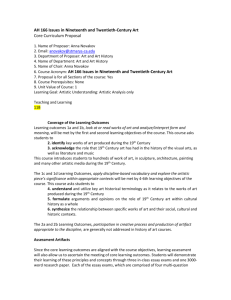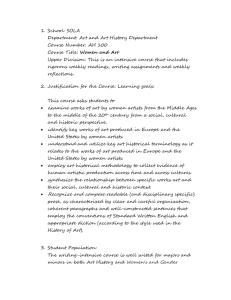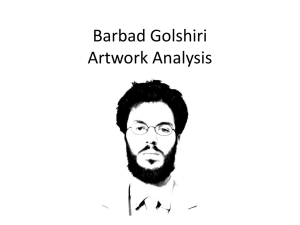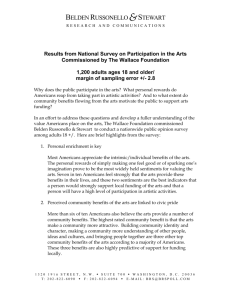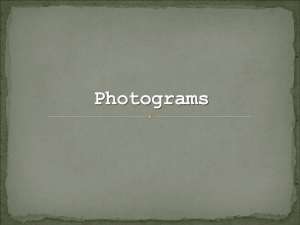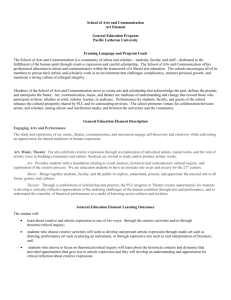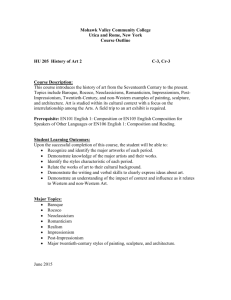Abstract Art Twentieth-century art containing shapes that simplify
advertisement
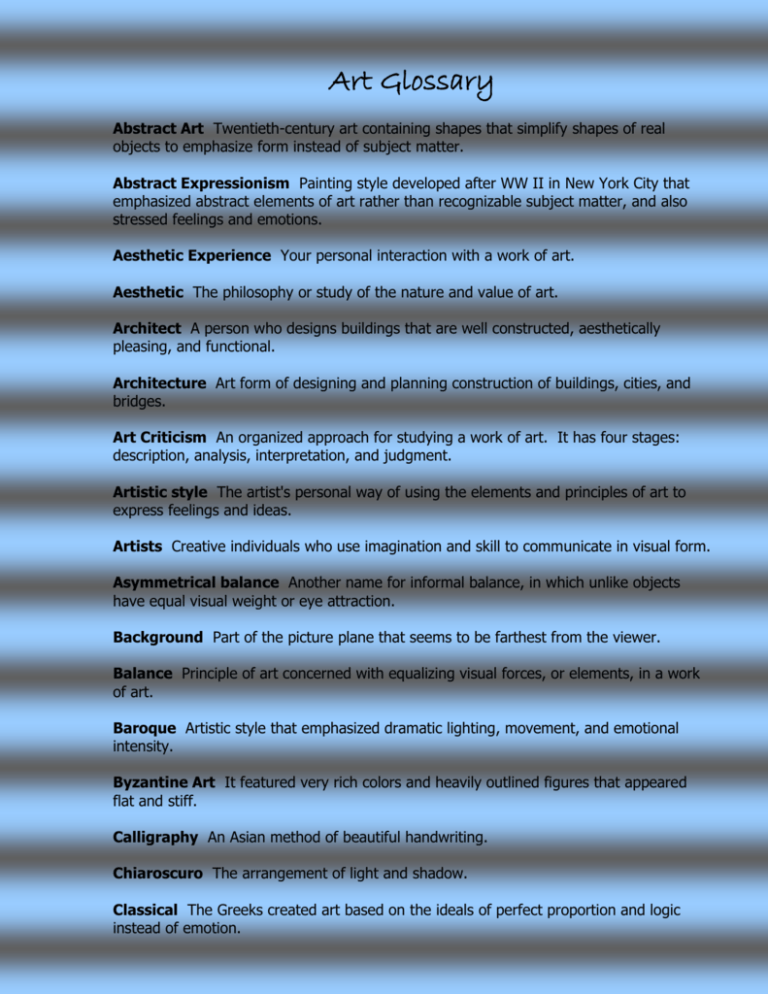
Art Glossary Abstract Art Twentieth-century art containing shapes that simplify shapes of real objects to emphasize form instead of subject matter. Abstract Expressionism Painting style developed after WW II in New York City that emphasized abstract elements of art rather than recognizable subject matter, and also stressed feelings and emotions. Aesthetic Experience Your personal interaction with a work of art. Aesthetic The philosophy or study of the nature and value of art. Architect A person who designs buildings that are well constructed, aesthetically pleasing, and functional. Architecture Art form of designing and planning construction of buildings, cities, and bridges. Art Criticism An organized approach for studying a work of art. It has four stages: description, analysis, interpretation, and judgment. Artistic style The artist's personal way of using the elements and principles of art to express feelings and ideas. Artists Creative individuals who use imagination and skill to communicate in visual form. Asymmetrical balance Another name for informal balance, in which unlike objects have equal visual weight or eye attraction. Background Part of the picture plane that seems to be farthest from the viewer. Balance Principle of art concerned with equalizing visual forces, or elements, in a work of art. Baroque Artistic style that emphasized dramatic lighting, movement, and emotional intensity. Byzantine Art It featured very rich colors and heavily outlined figures that appeared flat and stiff. Calligraphy An Asian method of beautiful handwriting. Chiaroscuro The arrangement of light and shadow. Classical The Greeks created art based on the ideals of perfect proportion and logic instead of emotion. Collage An artwork onto which materials such as textured paper and fabric have been attached. Color An element of art that is derived from reflected light. Color wheel The spectrum bent into a circle. Composition The way the principles of art are used to organize the elements of art. Contour drawing Drawing in which only contour lines are used to represent the subject matter. Contour line A line that defines the edges and surface ridges of an object. Contrast Technique for creating a focal point by using differences in elements. Crafts Art forms that are both beautiful and useful. Include weaving, fabric design, ceramics, and jewelry making. Credit line A list of important facts about a work of art. Includes the artist's name, the title of the work, year completed, medium used, size height, width, and depth), location (gallery, museum, or collection and city), donors, and date donated. Criteria Standards of judgment. Crosshatching The technique of using crossed lines for shading. Cubism Twentieth-century art movement that emphasizes structure and design. Threedimensional objects are pictured from many different points of view at the same time. Description A list of all the things you see in the work. Design qualities How well the work is organized. Dimension The amount of space an object takes up in one direction. Emotionalism Theory that requires that a work of art must arouse a response of feelings, moods, or emotions in the viewer. Emphasis Principle of art that makes one part of a work dominant over the other parts. Expressionism An art style that emphasized the expression of innermost feelings. Fauves A group of early twentieth-century painter who used brilliant colors and bold distortions in an uncontrolled way. Fine Art Art made to be experienced visually. Focal point The first part of a work to attract the attention of the viewer. Foreground Part of the picture plane that appears closet to the viewer. Foreshortening To shorten an object to make it look as if it extends backward into space. Form Objects having three dimensions. Formalism A theory that places emphasis on the design qualities. Freestanding Work of art surrounded on all sides by space. Functional Art Works of art made to be used instead of only enjoyed. Futurist Early twentieth-century Italian artists who arranged angular forms to suggest motion. Geometric Shapes Precise shapes that can be described using mathematical formulas. Gesture Drawing Line drawing done quickly to capture movement of the subject’s body. Gothic Artistic style developed in western Europe between the twelfth and sixteenth centuries. Featured churches that seemed to soar upward, pointed arches, and stainedglass windows. Harmony The principle of art that creates unity by stressing similarities of separate, but related parts. Hatching Techniques of shading with a series of fine parallel lines. Highlights Small areas of white used to show the very brightest spots. Hue The name of a color in the color spectrum. Imitationalism An aesthetic theory focusing on realistic presentation. Implied lines A series of points that the viewer’s eyes automatically connect. Impressionism Style of painting started in France in the 1860s. It featured everyday subjects and emphasized the momentary effects of light on color. Individual Style The artist’s personal way of using the elements and principles of art to express feelings and ideas. Intensity The brightness or dullness of a hue. International Style A style of architecture developed after World War II that emphasizes a plain, austere building style. Interpretation In art criticism, the step in which you explain or tell the meaning or mood of the work. Judgment In art criticism, the step in which you determine the degree of artistic merit. Line An element of art that is the path of a moving point through space. Literal qualities The realistic qualities that appear in the subject of the work. Logos Symbols or trademarks that are immediately recognizable. Mannerism European sixteenth-century artistic style featuring highly emotional scenes and elongated figures. Matte Surface Surfaces that reflect a soft, dull light. Media or Medium Material used to make art. Mexican Muralists Early twentieth-century artists whose paintings on walls and ceiling used solid forms and powerful colors to express their feelings about the Mexican Revolution. Middleground The area in a picture between the foreground and the background. Minimalism The twentieth-century artistic style that uses a minimum of art elements. Movement The principle of art used to create the look and feeling of action and to guide the viewer’s eyes throughout the work of art. Mosaics Pictures made with small cubes of colored marble, glass, or tile and set into cement. Negative spaces Empty spaces surrounding shapes and forms of the subject. Neoclassicism The French artistic style developed in the nineteenth century after the Rococo style. An approach to art that borrowed subject matter and formal design qualities from the art of Greece and Rome. Nonobjective Art Art that has no recognizable subject matter. Optical Art Twentieth-century artistic style in which artists use scientific knowledge about vision to create optical illusions of movement. Organic shapes Shapes or forms made by nature. Outline A line that shows or creates the outer edges of a shape. Pattern A two-dimensional decorative visual repetition. Perceive To become deeply aware through the senses of the special nature of a visual object. Perspective A graphic system that creates the illusion of depth and volume on a twodimensional surface. Pop Art The artistic style used in the early 1960s in the United States that portrayed images of popular culture. Positive space Shapes or forms in two- and three-dimensional art that make up the subject. Post-Impressionism The French painting style of the late nineteenth century that stressed a more individual approach to painting, unique to each artist working at the time. Post-Modernism An approach to art that incorporates traditional elements and techniques while retaining some characteristics of modern art styles or movements. Proportion Principle of art concerned with the size relationships of one part to another. Realism Mid-nineteenth-century artistic style in which presented familiar scenes as they actually appeared. Realists Artist in the nineteenth-century who portrayed political, social, and moral issues. Regionalists Artist who painted the farmlands and cities of the United States in an optimistic way. Relief Sculpture A type of sculpture in which forms project from a flat background. Renaissance The name given to the period at the end of the Middle Ages when artists, writers, and philosophers were “re-awakened” to art forms and ideas from ancient Greece and Rome. Reproduction A copy of a work of art. Rhythm The principle of art that indicates movement by the repetition of elements. Rococo An art style that stressed free graceful movement, a playful use of line, and delicate colors. Romanesque The style of architecture and sculpture that featured buildings of massive size; solid, heavy walls; wide use of the rounded Roman arch; and many sculptural decorations. Romanticism An art style that found its subjects in the world of the dramatic and in cultures foreign to Europe. It emphasized rich color and high emotions. Scale Size as measured against a standard reference. Sculpture A three-dimensional work of art created our of wood, stone, metal, or clay by carving, welding, casting, or modeling. Shading The use of light and dark lines to give a feeling of depth and texture. Shade A dark value of a hue made by adding black to it. Shape A two-dimensional area that is defined in some way. Sketch A quick, rough drawing without much detail that can be used as a plan or reference for later work. Space The element of art that refers to the emptiness or area between, around, above, below, or within objects. Still life A painting or drawing of inanimate (nonmoving) objects. Subject The image viewers can easily identify in a work of art. Surrealism A twentieth-century artistic style in which dreams, fantasy, and the subconscious served as inspiration for artists. Symbol Something that stands for, or represents, something else. Symmetry A special type of formal balance in which two halves of a balanced composition are identical, mirror images of each other. Texture The element of art that refers to how things feel, or look as if they might feel if touched. Tint A light value of a hue made by mixing the hue with white. Unity The quality of wholeness or oneness that is achieved through the effective use of the elements and principles of art. Value The element of art that describes the darkness or lightness of an object. Variety The principle of art concerned with difference or contrast.

